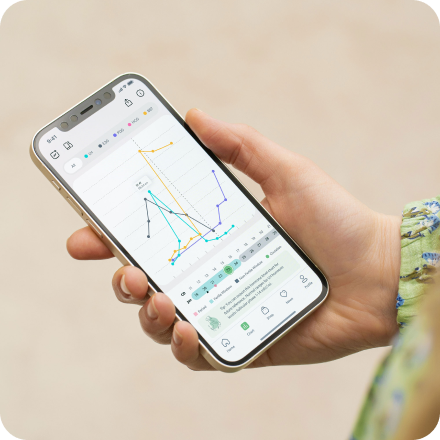FSH Levels in Women: What’s Normal? (+ FSH Levels Chart)
Released by the pituitary gland, follicle stimulating hormone (FSH) is a gonadotropic hormone that works alongside luteinizing hormone (LH) to regulate key reproductive processes. In women specifically, FSH is known for stimulating the early development of ovarian follicles, which eventually go on to release an egg during ovulation.

To help you better understand how this hormone works and what levels you can expect it to be throughout your menstrual cycle and beyond, here’s a closer look at what FSH is, what it does, and what are considered “normal” FSH levels. We’ll also cover what it may mean if your FSH levels are too high or too low, and how you can have your FSH levels tested.
While FSH is produced by both men and women, please note that this article focuses on the role that FSH plays in the female reproductive process.
What are normal FSH levels in women?
In women, FSH levels in the blood can range from as low as 0.1 mIU/mL during pregnancy to above 100 mIU/mL during menopause. Therefore, “normal” FSH levels vary depending on factors such as your age, whether or not you are pregnant, and what stage of the menstrual cycle you are in.
In women with regular menstrual cycles, FSH levels tend to range from 1.4-9.9 mIU/mL during the first half of the menstrual cycle before rising up to 17.2 mIU/mL during ovulation.
During pregnancy, FSH levels drop to ≤ 0.1 mIU/mL.
In women approaching menopause, FSH levels can vary dramatically depending on the regularity of their menstrual cycle. Once menopause is reached, FSH levels rise to above 30 mIU/mL, and can even reach over 100 mIU/mL.
What is FSH?
In women, FSH stimulates the premature or “primordial” ovarian follicle during the follicular phase of the menstrual cycle. This follicle contains a developing egg, and as it develops, FSH helps to initiate its production of estrogen. This influx of estrogen not only helps the follicle continue to develop, but it also helps to thicken the uterine lining.
Midway through the menstrual cycle, a surge of luteinizing hormone (LH) helps the follicle release the egg – which is called ovulation. After the egg is released, the remaining cluster of cells then forms the corpus luteum. The corpus luteum then continues to produce both estrogen and progesterone. Together, these hormones help to support the implantation process and early pregnancy.
Without FSH, the early development of ovarian follicles and the corpus luteum would not be possible.
Normal FSH levels and ranges
The following ranges are based on figures from the University of Rochester Medical Center. Please note that ranges may vary slightly among laboratories.
FSH levels before pregnancy
Before pregnancy, FSH levels typically range between 1.4-9.9 mIU/mL during the follicular phase, and 1.1-9.2 mIU/mL during the luteal phase.
During the follicular phase, FSH helps to stimulate the development of the ovarian follicle, so that it can eventually develop an egg and ovulate. During the luteal phase, FSH levels drop slightly but continue to stimulate the ovaries to produce estrogen and progesterone.
FSH levels during ovulation
During ovulation, FSH levels can range between 6.2-17.2 mIU/mL. At this time, both FSH and LH levels are at their peak and this spike in hormones causes the egg to be released (ovulation).

FSH levels during pregnancy
During pregnancy, all processes related to ovulation stop and FSH levels should remain low throughout an entire pregnancy. One study found that among pregnant women, FSH levels fall to a maximum of 0.1 mIU/mL as early as 26-30 days post ovulation.
FSH levels in perimenopause
During the transition to menopause (perimenopause), FSH levels can vary greatly. Therefore, you may see FSH levels anywhere between 1.4 mIU/mL to over 30 mIU/mL. However, when FSH levels test above 30 mIU/mL consistently, it is typically accepted that menopause has been reached.
Please note: only a healthcare professional can confirm your menopause stage.
FSH levels in menopause
During menopause, FSH levels can range from 19-100+ mIU/mL. This is because as women age, the number of follicles containing eggs at the beginning of the menstrual cycle (also called the ovarian reserve) gradually declines.
With fewer follicles available, estrogen levels drop. Because estrogen tells the body to stop producing FSH, a drop in estrogen causes FSH levels to increase.
FSH levels by age
| Age | FSH levels |
|---|---|
| 0-11 (before puberty) | 0-4.0 mIU/mL |
| 11-14 (during puberty) | 0.3-10.0 mIU/mL |
| 14-40’s (menstruation) | 4.7-21.5 mIU/mL |
| 40’s+ (after menopause) | 25.8-134.8 mIU/mL |
FSH levels chart
| Reproductive stage | FSH levels |
|---|---|
| Before puberty | 0-4.0 mIU/mL |
| During puberty | 0.3-10.0 mIU/mL |
| Women who are still menstruating | 4.7-21.5 mIU/mL |
| After menopause | 25.8-134.8 mIU/mL |
FSH levels changes
What if I have high FSH levels?
If you are in your 40’s or 50’s, high FSH levels may be a sign that you are approaching menopause. Typically, doctors will say that you have reached menopause if your LH levels consistently test over 30 mIU/mL for a period of time.
In addition to high FSH levels, you may also find yourself experiencing other symptoms of menopause such as fatigue, mood swings, vaginal dryness, and hot flashes. To treat these symptoms, your doctor may recommend hormone replacement therapy. Many doctors also recommend certain lifestyle changes such as trying cognitive behavioural therapy (CBT), eating a balanced diet, and exercising regularly as ways to manage menopause symptoms.
POI is another condition that may cause FSH levels to be higher than average. This condition occurs in women under the age of 40 and causes the ovaries to stop functioning properly. Symptoms of POI include irregular menstrual periods, difficulty with getting pregnant, and experiencing common symptoms of menopause.
To treat POI, doctors may recommend hormone replacement therapy. If you have POI and are trying to conceive, you may want to consider fertility treatments such as in-vitro fertilization (IVF).
What if I have low FSH levels?
Low FSH levels are not common and may indicate that there is a problem with your pituitary gland. For example, hypopituitarism is a rare condition that prevents your body from making enough hormones, which can result in low levels of FSH.
Symptoms of hypopituitarism include stomach pain, excessive thirst, excessive urination, fatigue, anemia, and weight fluctuations. To diagnose hypopituitarism, your doctor will want to check your hormone levels with a blood test. This may be followed by an MRI of your pituitary gland.
In addition to hypopituitarism, being underweight can also cause disruptions with your hormones. If you are struggling to maintain a healthy weight, it’s a good idea to speak with your doctor about strategies for gaining weight safely.
Testing FSH levels
Testing your FSH levels may be necessary if you are struggling to become pregnant, have an irregular menstrual cycle, or if your periods have stopped and you think it may be due to menopause. Additionally, it may also be necessary if you are experiencing common symptoms of a pituitary disorder such as fatigue, weight loss, or a decrease in appetite.
If you need to have your FSH levels checked, here are your testing options both at home and at your doctor’s office.
It’s important to note here that due to the fluctuations of FSH throughout the menstrual cycle, it is critical to test for FSH at the right time. The best time to have an FSH test is on the third day of your menstrual cycle, with day 1 being the first day of your period.
At home
When it comes to testing for FSH at home, there are currently two options. The first option is to take an FSH urine test. This type of test is very similar to a standard pregnancy test, but instead of testing for hCG (human chorionic gonadotropin), this test measures FSH.
The Mira Ovum wands (work together with a Mira analyzer) have a lot of benefits as an accurate, non-invasive FSH urine testing tool. It provides cycle charting, exact numeric results (instead of OPK’s blurry line), and able to monitor hormone levels through the whole cycle, day by day.
In addition to a urine test, there are also at-home blood tests that you can order online. These tests typically require you to collect a finger prick of blood and then send it to a lab for testing. You will then receive the results of your exact FSH levels within a few business days. The most common brands for at-home blood testing include LetsGetChecked and Everlywell.
At the doctor
You can also have your FSH levels tested at your doctor’s office. This typically involves a nurse withdrawing a small amount of blood from a vein in your arm. Your doctor will then send your blood sample to an external lab to be tested. Within a few days, your doctor will give you a call to discuss your results and any next steps.
While precise, this FSH testing method can be expensive and hard to do regularly given the scheduling requirements.
Take the Quiz!
Tell us your fertility goal and we'll give you a perfect product match
Mira’s Editorial Process
All content produced by Mira meets stringent editorial standards, ensuring excellence and accuracy in language and medical precision. Every piece undergoes thorough fact-checking and review by qualified professionals. Check out our full editorial process to learn more.













